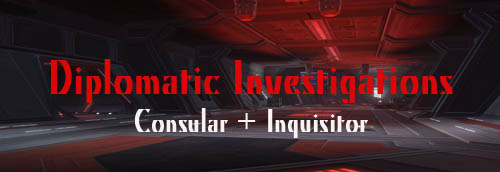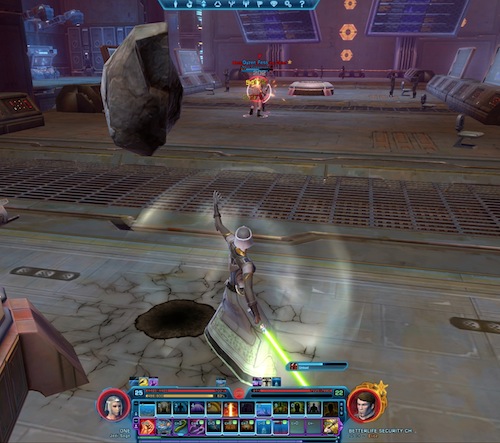It’s with a great deal of pleasure we introduce Tim Buchalka to the TOROZ team. You can find out lots more about Tim here – but suffice it to say he’s a rather dedicated connoisseur of the Inquisitor and Consular classes, which will be the focus of this column. We’ve called it Diplomatic Investigations as both words are synonyms (sort-of) for the Consular and Inquisitor. Nerdy grammar humour indeed. Anyway, please make Tim welcome and post your comments below!
Today I am going to focus on the Jedi Sage/Sith Sorcerer, which are the “other” lightsaber wielding classes in SWTOR. In case you are unaware, when you create a Jedi Consular or Sith Inquisitor character in SWTOR, at or around level 10 when you do your advanced training, you get the choice of becoming a Jedi Sage/Sith Sorcerer or Jedi Shadow/Sith Assassin.
The Sage/Sorcerer classes are almost identical other than the fact one is Jedi and the other Sith – their skills and abilities are very similar (albeit it with different names) and the damage they do is also similar.
I’ll focus on the Shadow/Assassin in future articles but for now lets talk tactics for the Sage/Sorcerer.
Basic Attack Strategies
One of the biggest things to remember is that despite how cool the lightsaber looks, it does very little damage – I recommend you don’t use it. Don’t worry, you will get to at least see it in your hand, you just don’t get to fight with it 🙂
It’s important to remember that these guys are not tanks, have light armour only, and are not melee characters. Typically you will get best results sending your companion in to do all the “dirty work” with your enemies i.e. melee attacks; leaving you to stand back (usually a long way back) and attack from a position of relative safety.
Incidentally, don’t be afraid to turn and run if your companion gets defeated. You can always come back for another shot later – a Sage/Sorcerer hero fighting to the death without a companion usually becomes a dead hero very quickly!
My first character on SWTOR was an imperial agent Operative, which is very much a melee character. After playing that for some time, when I swapped over to my Sage and Sorcerer (I am levelling both at present) it took a while for it to sink in that I should not be trying to get involved in melee. In fact, when I played my first Flashpoint (Black talon) I was asked why I was using my lightsaber in combat. After being asked, I actually took a look at the damage it was doing and it was very minimal compared to my other ranged attacks. I suggest you do the same, do away with the lightsaber in fights.
Stuns/Interrupts
One other important tactic is the use of stuns/interrupts and slow attacks during fights, especially with bosses. I’m talking here about the Mind Snap, Force Stun and Force Slow if you are a Jedi Sage or Jolt, Electrocute or Shock attacks if you are a Sith Sorcerer.
You may not have noticed but the harder to kill elite characters and bosses often have special attacks that usually do significantly more damage than their regular ones. If you can prevent these attacks altogether (or interrupt them if they have already started) it can spare you or your companion a significant amount of damage. This is even more important in flashpoints when every enemy is that much harder to defeat.
Watch for the blue bar on screen (below the red health indicator on your enemy). If you see a blue bar moving from left to right it means a special attack is being charged – now is the time to issue a Mind Snap or a Jolt. Do that before the blue bar gets to the right hand side and it means you have prevented the attack from starting (also stopping the enemy from using that attack for 4 seconds). If it has already been cast you may see a blue bar moving from right to left (if it’s a damage over time attack). Your interrupt will stop it dead in its tracks, meaning the rest of the damage is not inflicted.
See the image below of my Sage attacking a Betterlife Security Chief where he has already used his special attack (you can see the blue bar just above my companions). It also serves as a reference of how far I suggest you stand away from the main fight. No need to be any closer than absolutely necessary.
Likewise, stuns and slows do what they suggest they will – they can stun an enemy (preventing them from moving or attacking) or slow their speed down, allowing you (and your companion) to get some extra attacks in while it is in force. Most of these attacks have a cooldown before they can be reissued (for example Jolt/Mind Snap is 12 seconds) so in a big fight be sure to check when you can re-issue it. I’ve used this tactic in big battles with good effect.
Healing
I used to think this was a given but I have done a lot of flashpoints and teamed up with other Sage or Sorcerer players and I see them often not healing their companions. They just let their companion fight to the death and don’t attempt to heal them. As a result they cannot handle the bigger fights easily or they can get overwhelmed if larger numbers of the enemy are involved.
The thing to remember with the Sage and the Sorcerer is that it’s the companion taking all the damage (Qyzen Fess if you’re a Sage or Khem Val if you are a Sorcerer). These companions are good at holding aggro, ensuring the enemies keep attacking them rather than you. As a result it makes sense to heal them when their health is starting to get low, because if they are defeated guess who is going to be attacked next? I typically monitor the health of my companion during fights and when his health has dropped to around 25 percent or less, I stop attacking and focus on healing him.
With a boss fight I usually start healing when the health has dropped 40-50 percent since Bosses tend to do more damage and the more powerful healing spells take a while to cast. The last thing you want to do is stop attacking to heal your character but find you have left it too late and he is defeated while you are still casting. Not only have you lost the companion, but you have also not been inflicting any damage while you have been trying to heal. It can be a little unnerving focusing on healing when your companion is in a fight with 2-3 enemies and your natural instincts are to fight, but the thing to remember is, if your companion is alive its likely you are too! It can take a while to get the timing right but it’s an important skill to learn and will really help you in the tougher fights.
And as mentioned early, because you are a long way from the action (well out of melee range) – if it appears you cannot save your companion and looks unlikely that you are going to win, turn around, cast Force Speed and get out of there fast!
Companions Weapons and Armour
You should be continually upgrading your companion’s armour and weapons. This ensures that they can inflict and absorb a lot of damage. It also increases the threat level of your companion making it more likely he will be attacked and not you. It’s not uncommon in a big fight to find an enemy who is attacking you suddenly turn and race to attack your companion. Some of this is because they have good armour and weapons, but also Qyzen and Khem Val both have good AOE (Area of Effect taunts) which they will use to ensure enemies attack them and not you. As a worse case scenario you can cast something like a Cloud Mind, which reduces your threat level, but I almost never need to use this.
Remember the Force Armor/ Static Barrier
A cool defence against damage is Force Armor (Jedi Sage) and Static Barrier (Sith Sorcerer). This protects you from a high amount of damage for 20 seconds but also has a 20 second cool down. My rotation before attacking usually consists of casting this first, then instructing my companion to begin an attack, followed by casting a ranged attack with a long activation time like the Jedi Sage’s Mind Crush. That way, in most fights my companion has reached the enemy as my first ranged attack hits them, my shields (Force Armor or Static Barrier) are up, and I am in the position to start my attack with instant ranged attacks.
So there you go. These are pretty basic tips I know, but I have found them to be quite valuable and they collectively helped me get out of some tricky situations, sometimes when the odds are stacked against me.
I hope you enjoyed this article. I’ll be back next week with more Consular and Inquisitor tips. If there is anything specific you would like me to cover, or have any comments feel free to leave your thoughts below, I would love to hear from you!




Hi there I was wondering if you could enlighten me on the value of using project as a shadow
I seem to have quite a few talents and abilities that increase the critical chance of it and reduce it’s force cost but it doesnt seem to do as much as a good old fashoined backstab
Hi Alex,
Project is most useful as a high threat ability – It’s a tanking ability and useful to pull aggro from other group members. Shadows make excellent tanks. This is of course completely different to the Inquisitor class which most certainly is not a tank.
So in summary it’s main use is to get the enemy to attack you instead of your companion or other group members.
Hope this helps.
I love my heal-spec sorcerer. It’s awesome just using force abilities & makes me wish we could keep the lightsabre holstered during fights just to look more bad-ass.
Solo play goes a bit slower with heal talents but the upgrades to Static Barrier really are nice (reduced cost + reduced cooldown), particularly for teaming with a party.
Have to agree on the heal-spec. My jedi sage is heal spec so I know what you are saying.
I have to say I have not really felt the slowdown on solo play. And with a few flashpoints there has been someone else who want to heal so I went DPS and feel I contributed very well.